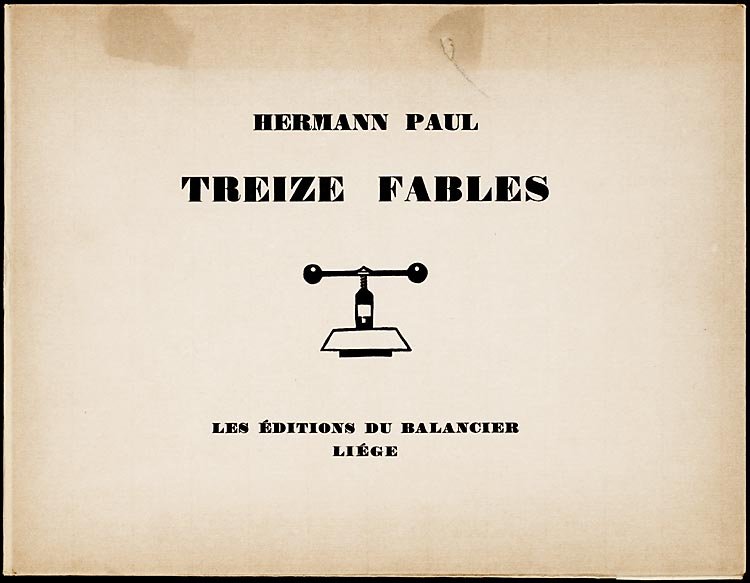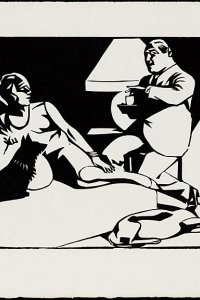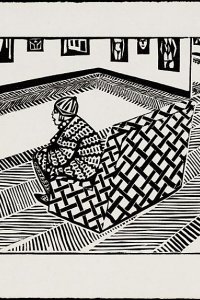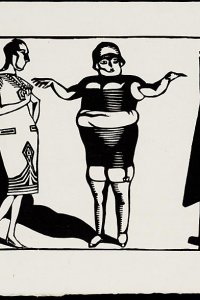Treize fables
- Year:
- 1928
- Author:
- Hermann René Georges Paul (1864 - 1940)
- Artist:
- Hermann René Georges Paul (1864 - 1940)
- Publisher:
- Éditions du Balancier
Lithographies by Hermann-Paul
The artist Hermann-Paul made his first lithograph in 1891, the same year in which Henri de Toulouse-Lautrec began to experiment with this medium. Both artists contributed lithographs to the prestigious series L’Estampe Originale: Hermann-Paul one and Toulouse-Lautrec four. Hermann-Paul’s lithographs were usually printed in magazines, such as the political cartoons he made in response to the Dreyfus affair. His street scenes are related to those of the Nabis painters with whom he sometimes exhibited. He also drew advertisements for theatre performances or exhibitions, such as the one for the Salon des Cents in 1895. But he did not limit himself to lithographs.
Against the bourgeoisie
From the First World War onwards, Hermann-Paul mainly made woodcuts. He visited the front and recorded the horrors of war. In 1915, a selection of his war prints was exhibited in the Stedelijk Museum Amsterdam. The Nieuwe Rotterdamsche Courant (5 December 1915) praised the élan, the ‘sharp conciseness’ and the ‘love’ and ‘hate’ expressed in them. His ‘bitter’ sketches of the bourgeoisie were also noticed in Dutch newspapers. Hermann-Paul loved to ridicule the bourgeoisie. In Treize fables, his exasperation is clearly visible.
Caricatures in Treize Fables
Treize fables [Thirteen fables] portrays various ‘types’, such as shoppers, American tourists, and elderly citizens like a lady constrained by pearl necklaces. Hermann-Paul left large parts of the prints white or made large areas black. This - and the sketchy drawings - reinforces the caricatural effect of the prints.
Hermann-Paul himself wrote the short texts that accompany the prints, giving them an even more critical tone. An example is the young woman in the museum who experiences art as relaxing, at least when she is resting on a bench: ‘L’art! Ah! Quel repos...’ [Art! Ah! How relaxing...]. This duality of text and image is typical of the caricaturist and Treize fables is thus representative of Hermann-Paul’s post-war work.
Bibliographical description:
- Description:
- Treize fables / [gravées sur bois par] Hermann Paul. - Liège : Éditions du Balancier, 1928. - [15] pages, [13] leaves of plates : ill. ; 26×34 cm
- Printer:
- J.-E. Goossens (Bruxelles)
- Edition:
- 63 copies
- This copy:
- Number 14 of 63 on Montval laid paper
- Shelf number:
- KW KOOPM E 17
References
- Adolphe Brisson, Nos humoristes. Caran d'Ache, J.-L. Forain, Hermann-Paul, Léandre, Robida, Steinlen, Willette. Paris, Société d'édition artistique, [1900]
- L’estampe originale: artistic printmaking in France 1893-1895. Zwolle, Waanders Publishers; Amsterdam, Van Gogh Museum, 1991.
- Nabis 1888-1900: Pierre Bonnard, Maurice Denis, Henri-Gabriel Ibels, Georges Lacombe, Aristide Maillol, Paul-Elie Ranson, József Rippl-Rónai, Kerr-Xavier Roussel, Paul Sérusier, Félix Valloton, Jan Verkade, Edouard Vuillard. Paris, Réunion des Musées Nationaux, 1993
- ‘The Online Hermann-Pual Project’.
- K. Pamberg, Hermann René Georges Paul called Hermann-Paul (1864-1940): exhibition of works on paper. Londen, Stoppenbach & Delestre, 2001
- Fleur Roos Rosa de Carvalho, Marije Vellekoop, Prentkunst in Parijs. De rage van het fin de siècle. Amsterdam, Van Gogh Museum, 2012
- Maurice Talmeyr, ‘L’âge de l’affiche’, in: Revue des deux mondes, 66 (1 septembre 1896), p. 201-216.




